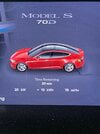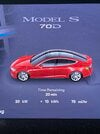I am starting this new thread because I haven't seen too many numbers specifically related to 70D and loss of supercharging speed. Specifically, I am referring to the original 70D that was introduced in April 2015. I have a high-mileage car (175,000 miles). Over time, supercharging has become a real chore. Initially, my charge power will be pretty good. On a recent trip, starting with 7% SOC, my charge rate began at 111kW. Not bad when compared to new when I would frequently see 117kW. However, tapering begins immediately. As you can see from the graph below, within 4 minutes rate is below 80kW and within 13 minutes is down to 59kW. Then it stays in the 40s and 50s for the remainder of the session.
The estimates on the MCI ("x minutes until you can continue your drive") are way off, frequently by a factor of two. 30 minutes is closer to an hour.
I am curious what others' experience is to see if this is a common trend or if perhaps there is something wrong with my car (e.g., cooling system issue). Please share your data if you can.
(software version 2020.24.6.11, approx 174,500 miles)

The estimates on the MCI ("x minutes until you can continue your drive") are way off, frequently by a factor of two. 30 minutes is closer to an hour.
I am curious what others' experience is to see if this is a common trend or if perhaps there is something wrong with my car (e.g., cooling system issue). Please share your data if you can.
(software version 2020.24.6.11, approx 174,500 miles)




